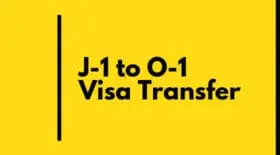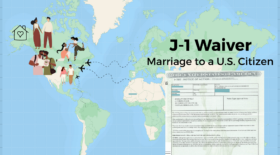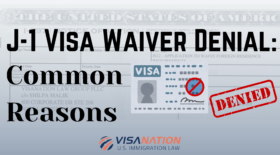For J-1 visa holders in the U.S. seeking to transition to a U.S. green card, there are a few hurdles that you should be aware of that must be addressed before attempting to change status. This guide provides an overview of the J-1 visa to green card process.
Can a J-1 Visa Holder Apply for a Green Card?
Yes, it is possible for a J-1 Visa holder to apply for a green card, but the process must be navigated cautiously.
Because the J-1 is not considered a “dual intent” visa, you must demonstrate that you have ties to your home country (such as family or assets) that demonstrate your intent to return once your J-1 status has ended before you move to the United States.
Furthermore, J-1 visas often come with the 212(e) rule known as the Two-Year Home-Country Physical Presence Requirement, which requires specific J-1 visa holders to return home for two years.
Despite the hurdles, it is not impossible to go from a J-1 to a green card. Opportunities often arise for J-1 holders, such as marriage or employment-based sponsorship. You can apply for a green card by filing an immigrant visa petition without violating their status; however, these cases should be handled with care and the help of an experienced immigration attorney.
J-1 Waiver and Processing Times
The first obstacle to transitioning from J-1 to a green card is the home residency requirement. This requirement obligates most J-1 visa holders to return to their home country after their J-1 status has ended and remain there for two years before pursuing any further visas or green cards. After all, the whole idea behind the J-1 exchange visitor program is so that you can return home and bring what you learned in the U.S. to your country.
You can apply for a J-1 visa waiver to circumvent this requirement. There are five ways to obtain this waiver, and estimated J-1 waiver processing times are noted alongside each path.
- Through a No Objection Statement from your home country’s government indicating that your home country does not take issue with you staying in the U.S. (Estimated processing time 6-8 weeks)
- If returning home would expose you to the threat of persecution. (Estimated processing time 4-6 weeks)
- If returning home would cause extreme hardship to you or your family. (Estimated processing time 4-6 weeks)
- Through a federal government agency that takes a specific interest in you and requests your continued presence in the U.S. (Estimated processing time 4-6 weeks)
- Request by a Designated State Public Health Department or its Equivalent (Conrad State 30 Program). (4-6 weeks)
Even with the J-1 waiver, you could run into issues filing your green card petition if you cannot prove your initial intent was to leave after your J-1 period ended and that applying for your green card was not your plan all along. Because this can be a difficult thing to prove satisfactorily, it is advised to consult an immigration attorney during this process.

Another hurdle you may need to overcome is the fact that many programs revoke their sponsorship of you as soon as you file a petition for a green card. In some cases, this is because the sponsoring program may want to avoid developing a reputation with the USCIS as a J-1 program that can be used to get a green card. If your sponsor removes your sponsorship, you would be “out of status”, which could have serious consequences, including being barred from future attempts to immigrate to the U.S.
J-1 Visa to Green Card 90-Day Rule
The second obstacle for transitioning to a green card is that the J-1 is not a dual intent nonimmigrant visa, which means you must prove that you have the intention of returning to your home country after your program. While you may get a green card, you are still required to prove that you had no intention of pursuing a green card before receiving your J-1 visa.
The 90-day rule is used by the USCIS officers to determine whether or not a J-1 holder applying for a green card had immigrant intent from the beginning of the application process. If you apply for a green card within 90 days of entering the U.S., that will raise a red flag suggesting that you lied in your application and you didn’t have any plans to return to your home country. You will need to convince the immigration officials that your decision to get a green card wasn’t premeditated but came due to unexpected changes in your personal circumstances. Needless to say, this can be very difficult to prove without the help of an attorney.
Because of this, J-1 visitors are always advised to allow at least 90 days to pass before applying for a green card. Your I-94 travel record will help you determine how long you have been in the United States. With the date, you can calculate the 90-day rule by adding 90 days to the most recent arrival date stamped on your I-94.
NOTE: If this is not your first time in the United States or the J-1 is not your first U.S. nonimmigrant visa, the 90 days must be calculated based on the most recent entry. Here is how it works:
Example 1:
You originally entered the U.S. on a B-2 tourist visa, and after returning to your home country, you filed and received a J-1 visa. The 90-day rule will apply based on the date you reenter the U.S. on your J-1 visa, not on the initial B-2 visa.
Example 2:
You entered the United States on a B-2 visa, and while you are still in the U.S., you applied for and received a J-1 visa before the expiration of your B-2 visa. In this case, the 90-day rule would be the date you entered with your B-2 visa, not the date you received your J-1 visa.
J-1 Waiver to Green Card Timeline
There are several stages that affect the processing time for the transition from a J-1 to a green card:
PERM Process
If you choose to go with either the EB-2 or the EB-3 employment-based green card, your employer will need to file a PERM Labor Certification on your behalf before they can file the I-140 petition.
- This involves having your employer run an extensive recruitment campaign advertising for your position, to ensure there are no qualified U.S. workers in the area that you would be displacing through your employment.
- Under normal circumstances, the PERM processing time takes:
- 60 days for the recruitment process
- ~16 months for the Department of Labor to reach a decision on your application.
If your employer is audited or subjected to supervised recruitment, your J-1 waiver to green card processing time will be greatly increased.
If you qualify for the EB-2 NIW or an EB-1 green card, the PERM process can be bypassed entirely.
I-140 Petition
The I-140 takes an average of six to eight months to process. If you would like to shorten this processing time, you can opt for premium processing. For an extra fee (payable by either you or your employer), premium processing will shorten your petition’s processing time to 15 business days.
Priority Date
You will need to wait until your priority date is current before filing to adjust your status. Your priority date is the day that the USCIS receives the PERM Labor Certification application or I-140 petition (for green cards that don’t require PERM).
You will need to regularly check the visa bulletin released monthly by the Department of State to see if your priority date matches or passes the filing date given in your category.
Once that happens, your priority date will be considered current, and you will be able to file to adjust your status from J-1 waiver to green card status.
The filing dates are based on your visa category (ie, EB2 vs EB-3) and country of origin.
Adjustment of Status (Inside the U.S.)
To adjust your status, you must file an I-485 form with the USCIS and wait an average of six to 12 months. This step cannot be expedited with premium processing and is only available to those who are currently in the U.S. under a nonimmigrant visa like a J-1.
Consular Processing (Outside the U.S.)
On the other hand, you can opt to go through consular processing. This may cut down on the cost and the processing time, but it requires you to make an appointment with the U.S. consulate or embassy in your home country and participate in a one-on-one interview.
Work with your immigration attorney to determine if this is a better option depending on your situation.
Optional Transition to Dual Intent Visa
Often, J-1 holders will transition to a dual intent nonimmigrant visa to extend their time in the United States, which also enables them to transition to a green card without any issues regarding intent.
For example, many choose to the H-1B visa, requiring J-1 holders to partake in the annual H-1B lottery and the waiting times that accompany that process. Speak with your immigration attorney to determine which route is best for your case.
J-1 to Green Card Through Marriage
Marriage is another way of transitioning from a J-1 visa holder to a green card holder. If you are married to a U.S. citizen or lawful permanent resident, your spouse can sponsor you to become a lawful permanent resident yourself. In this case, you will still need to either obtain a waiver or wait until after the two-year requirement for the home country assignment has passed before beginning your green card process.
If you are not subject to the home country physical presence requirement, you can begin your J-1 to marriage-based green card process once your spouse is ready to sponsor your application.
J-1 to Marriage-Based Green Card Processing Times
The processing time will depend on whether you are married to a citizen or a lawful permanent resident. Unlike the employment-based green card application that uses the I-140 form, the marriage-based category will require your spouse to submit an I-130, Petition for Alien Relative. It must be submitted with these marriage-based green card supporting documents.
Married to a U.S. citizen: If you are married to a U.S. citizen, the processing time will be shorter, as a visa is always available without wait times. Thus, you will be able to file both the I-130 and I-485 concurrently (at the same time). This means the USCIS will adjudicate both applications simultaneously, thereby shortening the entire process.
Depending on the workload at the USCIS service center in charge of your case, you should be able to receive a decision on your petition within 6-12 months, although adjudication can occasionally be shorter or longer than this range. VisaNation lawyers have seen approvals as little as three to four months.
Married to a Lawful Permanent Resident: Unlike the spouses of U.S. citizens, a green card is not readily available to the spouse of a permanent resident. After your spouse has filed the I-130 form, you will first wait for the petition to be approved.
After the approval, you will need to wait until a green card number is available to you before you can file your I-485 form. Depending on the backlog of applications ahead of you in the green card waiting line, you may need to wait for several months or years before you can receive your green card. Reference the latest visa bulletin to estimate the waiting time.
J-1 to Green Card Through An Employer
The typical employment-based process is for applicants to obtain an employer willing to sponsor them. The first step is the PERM Labor Certification. The purpose of the PERM Labor Certification is to verify that the offered position cannot be completed by a qualified, able, and available United States worker.
If the PERM application is authorized, the U.S. employer is capable of filing for the I-140 on the J-1 visa holder’s behalf. After the priority date is current in the visa bulletin, the applicant can then file for an adjustment of status with the I-485 form. The J-1 waiver cannot be administered until the U.S. employer has submitted an application for labor certification through the PERM.
J-1 Visa to Green Card Costs
The cost associated with making the switch from a J-1 to a green card:
Employment-based
The costs associated with an employment-based visa for applicants include
- Inside the U.S.:
- Adjustment of status $1,440 – For those applying from inside the U.S. on a valid non-immigrant status
- Outside the U.S.:
- Immigrant Visa Application fee ($345)
- USCIS Immigrant Fee ($220): Paid for the permanent resident card
Your employer will be responsible for the $715 basic filing fee for the I-140 (Employer fee)
Marriage-based
|
Form Filing Fee |
Applying from Outside the U.S. |
Applying from Inside the U.S. |
|
I-130: Petition for Alien Relative |
$675 (paper filing) or $625 online filing) |
$675 (paper filing) or $625 online filing) |
|
I-485: Green Card Application |
Not Applicable |
$1,440 |
|
I-864: Affidavit of Support |
$120 |
$0 |
|
State Department Processing |
$325 |
Not Applicable |
|
USCIS Immigrant Fee |
$235 |
Not Applicable |
|
I-131: Travel Permit (Optional) |
Not Applicable |
$630 |
|
I-765 Work Permit (Optional) |
Not Applicable |
$260 |
|
Medical appointment and vaccines |
Varies |
Varies |
J-1 Waiver Green Card Process
To get a green card while on J-1 status, the applicant has three possible options concerning the waiver:
- Submit the immigrant petition and J-1 waiver concurrently, along with evidence that you did not initially intend to get a green card.
- Submit the J-1 waiver, have the waiver approved, and then submit the immigrant petition.
- Submit the immigrant petition, have the immigrant petition approved, and then submit the J-1 waiver.
Additionally, to avoid the delicate nature of potentially violating your J-1 status, many people choose to change their status to a non-immigrant visa with dual intent.
Some popular options are the H-1B, L-1, or O-1 visas. You will have to factor in the processing time and money that is involved with getting a dual intent visa on top of the usual method of getting a green card.
Find out how your J-1 visa affects your taxes
J1 to H-1B Process
The H-1B visa is highly sought after due to its many benefits. If you are interested in transitioning from a J-1 visa to an H-1B visa, you can apply for it at the beginning of the new fiscal year if the numerical cap has not yet been met. If the proposed employer is exempt from the cap, the employer can file at any time, and you can begin working as soon as your petition is approved.
What if your J-1 visa has a two-year home residency requirement? Unfortunately, if that’s the case, you must go back to your home country for two years once you’ve completed your J-1 stint before you can apply for any type of work-based visa or green card, unless you can qualify for the J-1 visa waiver.
J1 Visa As it Pertains to Physicians
If the J-1 holder is a physician and would like to obtain a green card, the applicant should first file for a J-1 waiver. Once the J-1 waiver has been approved, the physician has two options:
- File for the PERM Labor Certification by a U.S. employer, or
- File for an EB-2 green card with a National Interest Waiver (NIW)
It is possible for physicians to have NIW and PERM applications pending at the same time.
If the applicant decides to go with this option, he/she cannot submit the I-485 until the completion of the J-1 Conrad 30 requirements (if applicable). The I-140 and I-485 may be filed at the same time if the dates are current. You can check the latest Visa Bulletin for this information.
If the physician selects the NIW option, the applicant can petition without a U.S employer. The physician may also submit an I-140 at the same time. However, the physician is only eligible to apply for the NIW if he/she has agreed to be employed in one of the areas:
- A health facility within a shortage area
- Mental Health Area
- Medically Underserved Area
- U.S. Veteran Affairs Facility
The physician must be ready to work in one of the approved areas for 3 years in order to be considered for the J-1 waiver green card.

J1 Waiver Status
You can find out the status of a pending waiver application on the U.S. Department of State’s J-1 Visa Waiver Division page.
Simply enter your case number, and in the block “Re-enter Case Number”, enter your case number again for confirmation and click the “Submit” button. As a side note, it’s wise to wait about a month after submitting your waiver application before checking the status. If all is on track, then when you click submit you will see that your application, supporting evidence and fee have all been received.
International Travel and Employment While Waiting for a Green Card
While your adjustment of status (I-485 form) is being processed, you should avoid traveling internationally until you have obtained a travel permit, which is officially known as Advance Parole Document. Without that, immigration officers may conclude that you have abandoned your green card application, which will require you to start the process all over again.
Similarly, you cannot work in the United States while your I-485 is pending until you have received a temporary work permit, otherwise known as an Employment Authorization Document (EAD). If you have an EAD, you can continue working and living in the United States even if your J-1 status has expired.
J-1 Status Expiration While Waiting for Green Card
If your J-1 status expires before an immigrant visa number becomes available, you will need to get a J-1 extension or apply to change your status to another nonimmigrant visa in order to continue staying in the U.S. while the green card application is pending.
Unfortunately, getting a J-1 visa extension or changing to another status isn’t always feasible. If you fail to do either, you will risk being flagged as being “out of status” if you continue living in the United States after the J-1 visa has expired. So, to avoid this, the only option would be to leave the U.S., return to your home country, and continue the process through consular processing whenever a visa number is available for you. You will need to file a DS-260 application at the embassy or consulate in your country of residence to request an immigrant visa abroad.
How VisaNation Can Help
Transitioning from a J-1 exchange visitor visa to a green card is a complex process. Getting a waiver for the home presence requirement, proving that your green card application wasn’t a preconceived idea, and several other intrigues surrounding the process require thoroughness. This is why you need the service of an immigration lawyer.
VisaNation Law Group has a team of highly experienced J-1 and green card immigration attorneys with excellent track records of helping many exchange visitors transition to lawful permanent resident status. Our immigration lawyers are capable of advising you on the decisions best suited to the qualifications and expectations of the visa.
Schedule a consultation with VisaNation Law Group today



